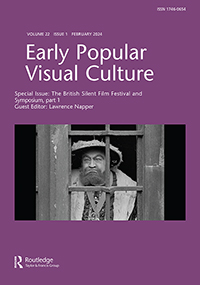Current issue
The British Silent Film Festival and Symposium, part 1. Guest Editor: Lawrence Napper
Register now or learn more

Start a new submission or continue a submission in progress
Go to submission siteReady to submit? Start a new submission or continue a submission in progress
Go to submission site (link opens in a new window)Early Popular Visual Culture (EPVC) is a peer-reviewed, academic journal dedicated to stimulating research and interdisciplinary studies in relation to all forms of popular visual culture before 1930.
EPVC examines the use and exploitation of popular cultural forms such as (but not limited to) cinema, photography, the magic lantern, panoramas, music hall, illustrated books and periodicals, cartoon strips, circus, stage performances, posters and caricatures in the fields of entertainment, education, science, advertising and the domestic environment, and is primarily concerned with the evolving social, technological and economic contexts which such popular cultural products inhabited and influenced.
The journal publishes a range of original historical, theoretical and methodological articles on early popular visual culture, as well as offering selected facsimile materials of obscure and rare sources, reviews and research reports. There are also regular special thematic issues. It is published in English only.
Peer Review Policy:
Unsolicited articles are subject to initial editor screening and anonymized reviewing by at least two anonymous referees. Articles in special issues and special sections are subject to initial editor screening via proposals and are then subject to review by one of the editors and by the guest editor.
Editorial Standards:
While Early Popular Visual Culture often publishes articles that discuss cultural works featuring dehumanising language uses and/or images (meaning that readers will be exposed to partial or full reproductions of historical works that would constitute hate speech if published for the first time today), the editorial standards of Early Popular Visual Culture include 1) that authors’ own original writing should not include dehumanising representations of any kind, in line with the academic principle of writing in value-neutral prose, and 2) that when authors discuss cultural works that include instances of dehumanising language use and/or images, authors’ own discussion of those instances should clearly identify the historical context that produced them, so as to minimise the risk of normalising those language uses and/or images in contemporary usage. Editors will work with authors who intend to include sensitive materials to ensure that the journal's editorial standards are met.
Also read our editorial: Sarah Dellmann, Joe Kember and Andrew Shail, ‘Towards a non-discriminatory, inclusive use of language and images in our journal’, Early Popular Visual Culture 15.4 (Nov 2017), 393-404. https://www.tandfonline.com/doi/full/10.1080/17460654.2017.1413826
"Here’s a delight, a scholarly journal that reveals a whole new perspective to the emergence of our modern visual culture in the last century that not only draws on the best scholarship working today, but also conveys the energy, diversity and wild imagination of its subject. We needed this journal!"
Professor Tom Gunning, University of Chicago
"This handsome new journal responds to a real need: the exploration of culture which thinks outside disciplinary boxes, and brings together experts from a wide range of backgrounds to focus upon the fascinating history of the visual."
Professor Jacky Bratton, Royal Holloway, University of London
Authors can choose to publish gold open access in this journal.
Read the Instructions for Authors for information on how to submit your article.
Explore the most recently published articles
The British Silent Film Festival and Symposium, part 1. Guest Editor: Lawrence Napper
Reach an engaged target audience and position your brand alongside authoritative peer-reviewed research by advertising in Early Popular Visual Culture.